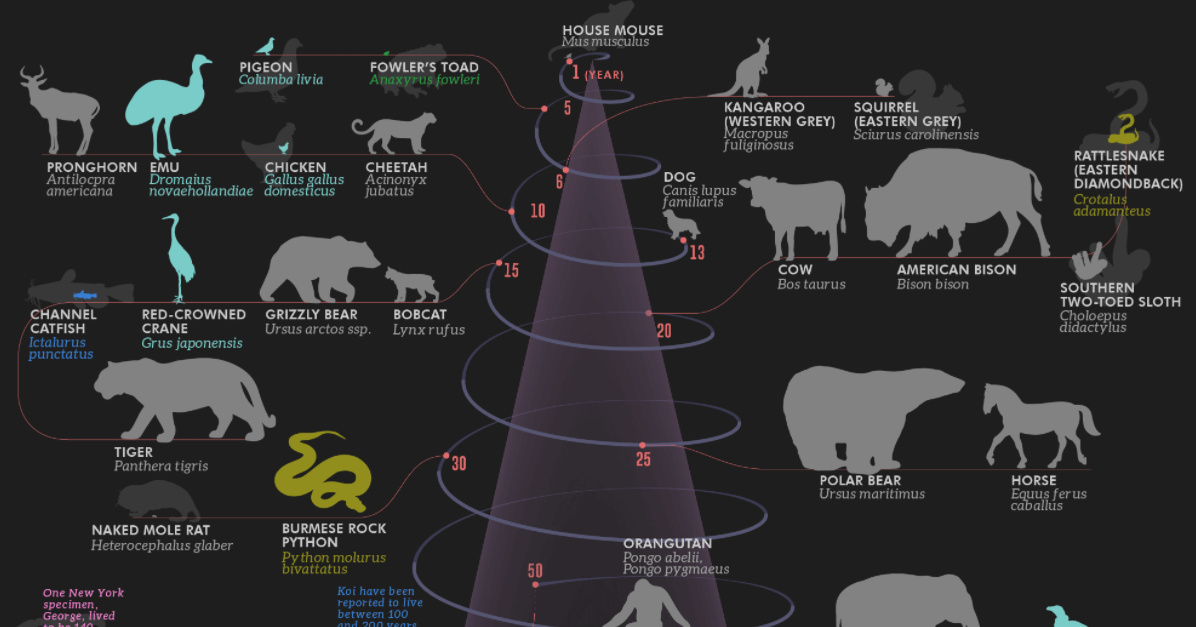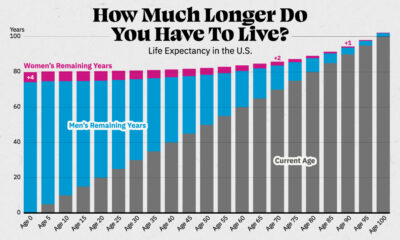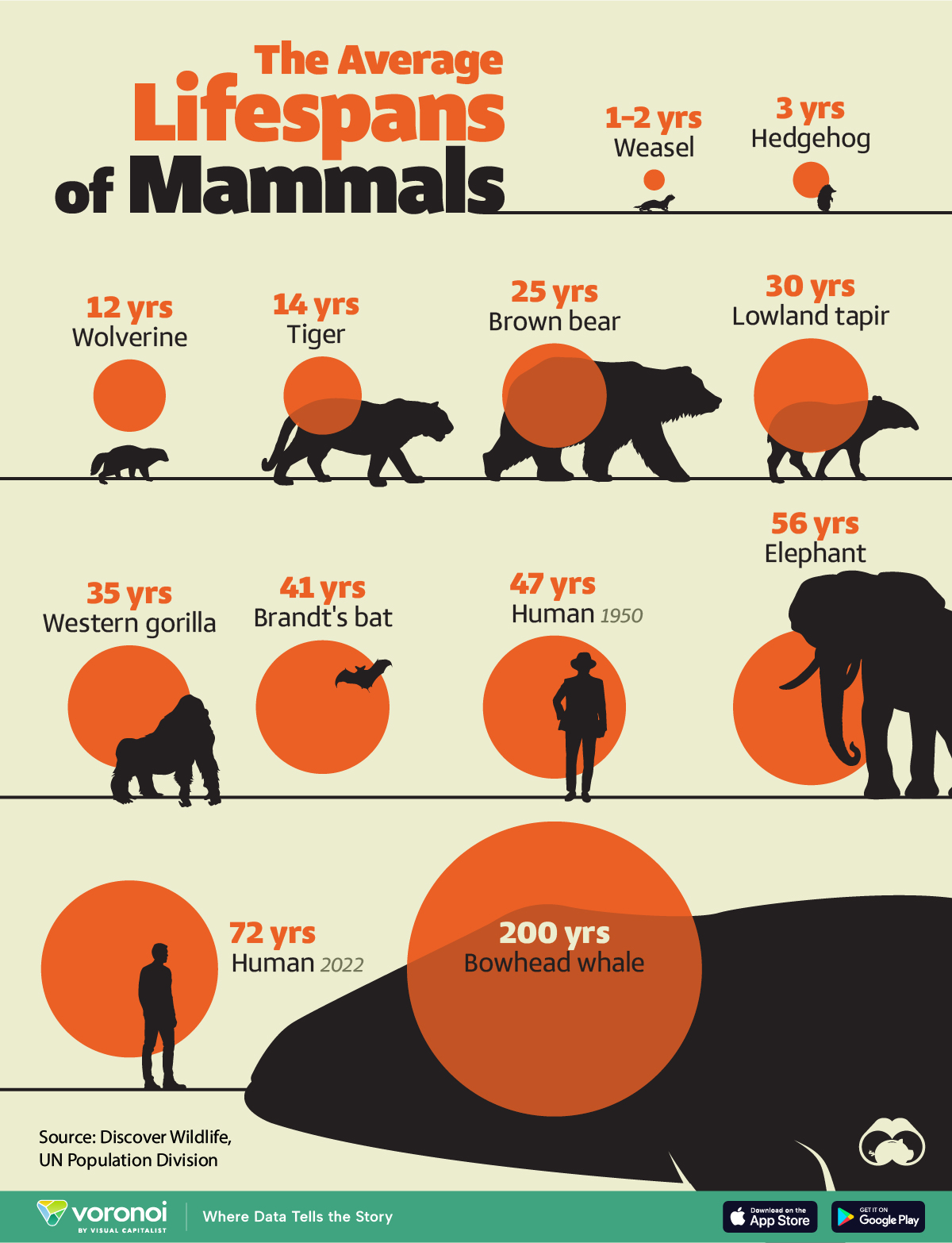Science
Ranked: The Life Expectancy of Humans and 49 Other Animals
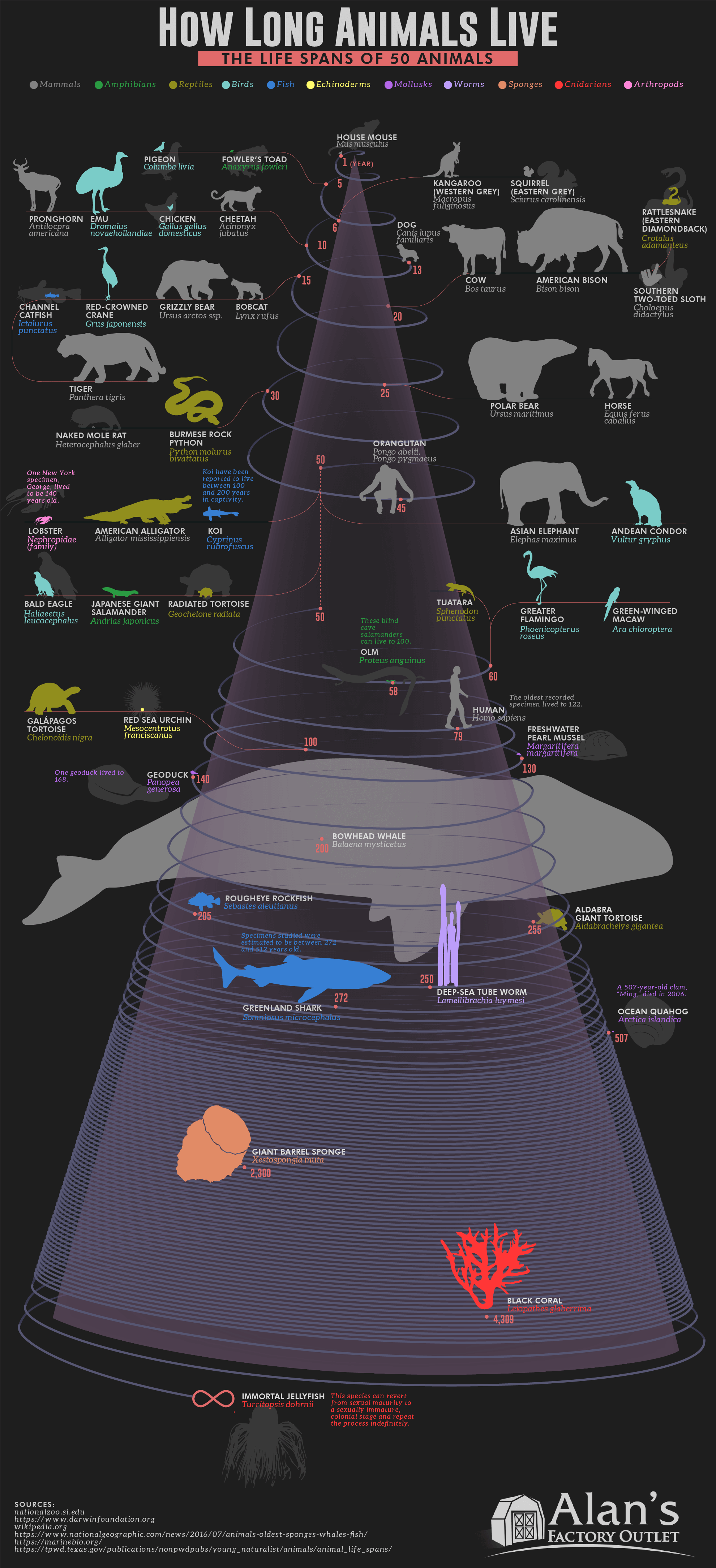
Ranked: The Life Expectancy of Humans and 49 Other Animals
For most of history, average life expectancy at birth for humans has stood around 30 years. But thanks to recent breakthroughs in technology and modern medicine, humans are now born with an average life expectancy closer to 80 years.
Some might argue this is one of mankind’s greatest achievements. With this rise in life expectancy, how do human lifespans now rank compared to other animals?
This graphic from Alan’s Factory Outlet covers the life expectancy of 50 different animals ranging from amphibians to arthropods, and even includes one species that’s immortal (well, in theory).
Let’s take a closer look at lifespans in the animal kingdom.
The Longest Living Things
Here are some of the longest living animals, where even with advancements in modern medicine, humans are likely far off from matching.
The Deep-Sea Tube Worm
The deep-sea tube worm, also known as Riftia pachyptila, lives until about 250 years old, though in some cases this can stretch much further.
Amazingly, they have no digestive system, mouth, or anus, and thus do not consume food to survive in a traditional sense. Instead, the bacteria living inside their bodies helps to transform the sulfur from nearby hydrothermal vents into energy.
This makes the deep-sea tube worm one of the few animals on Earth that does not derive its nutrients (either directly or indirectly) from sunlight.
The Immortal Jellyfish
The immortal jellyfish, otherwise known as Turritopsis dohrnii, is biologically immortal.
How is this possible?
Essentially, these creatures revert and transition backwards from sexual maturity towards sexual immaturity in a process called transdifferentiation—where adult cells are converted into other types of tissue. Not surprisingly, processes like these are getting plenty of human attention in gene therapy and scientific research.
Giant Barrel Sponge
The giant barrel sponge can live for 2,300 years. These cool creatures live on the reef surface of the ocean, and are bowl shaped, which provides habitat for many other invertebrates including crabs, shrimps, as well as fish. In addition, sponges have no tissue and each of their individual cells can do the same job of any other cell.
Some experiments have even shown sponges reform and have their cells swim back together when blended up in a blender. If they didn’t, that would be a very cruel experiment.
Human Lifespans: A Rising Trend To Watch
The number of centenarians—those 100 or more years old—stands at 570,000 today.
Here are the countries where they are most common compared to their respective populations.
| Country/Region | % Of Population |
|---|---|
| Japan | 0.062% |
| Uruguay | 0.061% |
| Hong Kong | 0.047% |
| Puerto Rico | 0.045% |
| France | 0.030% |
| Spain | 0.028% |
| Italy | 0.028% |
| Cuba | 0.027% |
While figures in the one-hundredth of a percent range may sound underwhelming, this is still a 1,500% jump from the 33,000 centenarians that lived in the 1950s.
Slowly but surely, as human life expectancy continues to grow, our species seems destined to climb up the age ladder—and who knows, we may even be able to eventually live beyond some of the other creatures on this list.
Science
Visualizing the Average Lifespans of Mammals
While smaller animals such as weasels typically live 1-2 years, larger counterparts can thrive for decades.
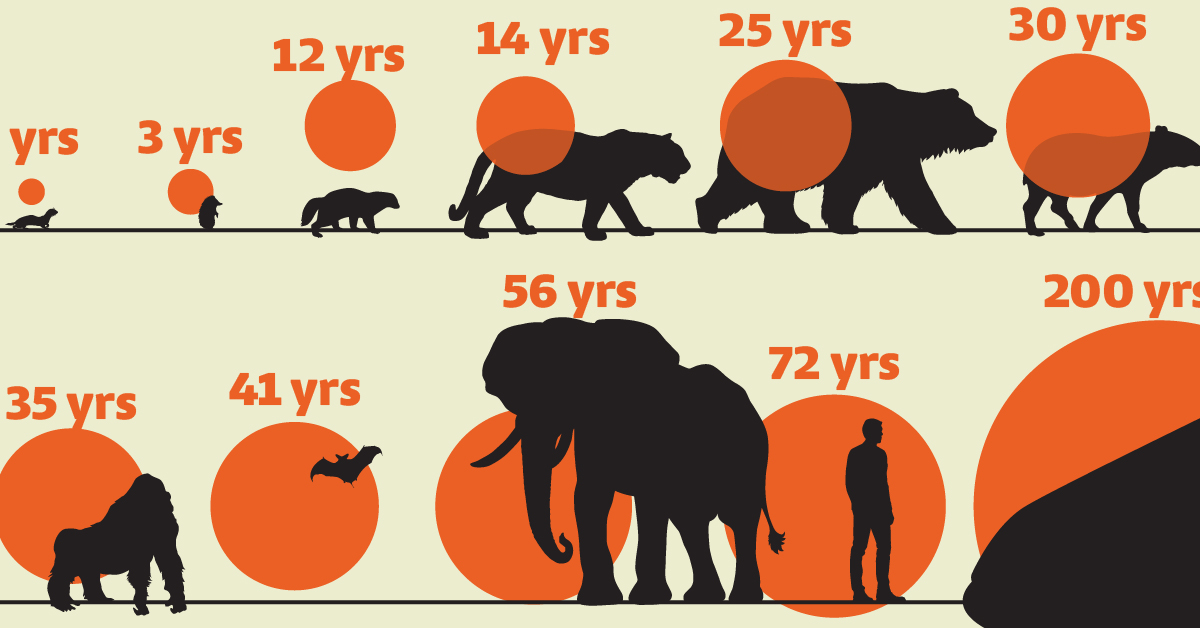
Visualizing the Average Lifespans of Mammals
This was originally posted on our Voronoi app. Download the app for free on iOS or Android and discover incredible data-driven charts from a variety of trusted sources.
Mammals, though comprising a small fraction of Earth’s creatures, hold vital ecological roles globally. They are crucial for maintaining ecosystem health through services like pollination, seed dispersal, and predator-prey dynamics.
In this visualization, we depict the average lifespans of mammals, using data from Discover Wildlife and the United Nations.
Human Lifespans on the Rise
Defined as warm-blooded creatures with hair or fur, mammals nurse their young with milk from mammary glands. While smaller animals such as weasels typically live 1-2 years, larger counterparts like elephants can thrive for decades, and bowhead whales can live for 200 years, or even longer.
| Animal | Average lifespan (years) |
|---|---|
| Weasel | 1 to 2 |
| Hedgehog | 3 |
| Wolverine | 12 |
| Tiger | 14 |
| Brown bear | 25 |
| Lowland tapir | 30 |
| Western gorilla | 35 |
| Brandt's bat | 41 |
| Humans (1950) | 47 |
| Elephant | 56 |
| Humans (2022) | 72 |
| Bowhead whale | 200 |
Notably, human lifespans have experienced a remarkable surge. According to the UN Population Division, the global average life expectancy has surged from 47 years in 1950 to 72 years in 2022, marking a 25-year increase. This is attributed to advancements in nutrition, medication, and essential resources.
However, as human longevity flourishes, it can have an adverse effect on wildlife mammal populations. To put this into numbers, over the past 100,000 years, the surge in human population has precipitated an 85% reduction in wild mammal biomass.
Today, livestock dominates 62% of the world’s mammal biomass, with humans accounting for 34%, while wild mammals comprise only 4%.
Despite a decline in mammal diversity, the total biomass of terrestrial mammals has significantly increased, expanding approximately ninefold over the past 10,000 years.
Curious to learn more about mammals? Check out this graphic that shows the biomass of all the world’s mammals.
-

 Demographics7 days ago
Demographics7 days agoThe Countries That Have Become Sadder Since 2010
-

 Green2 weeks ago
Green2 weeks agoRanked: The Countries With the Most Air Pollution in 2023
-

 Green2 weeks ago
Green2 weeks agoRanking the Top 15 Countries by Carbon Tax Revenue
-

 Markets2 weeks ago
Markets2 weeks agoU.S. Debt Interest Payments Reach $1 Trillion
-

 Mining2 weeks ago
Mining2 weeks agoGold vs. S&P 500: Which Has Grown More Over Five Years?
-

 Energy2 weeks ago
Energy2 weeks agoThe World’s Biggest Nuclear Energy Producers
-

 Misc2 weeks ago
Misc2 weeks agoHow Hard Is It to Get Into an Ivy League School?
-

 Debt2 weeks ago
Debt2 weeks agoHow Debt-to-GDP Ratios Have Changed Since 2000

